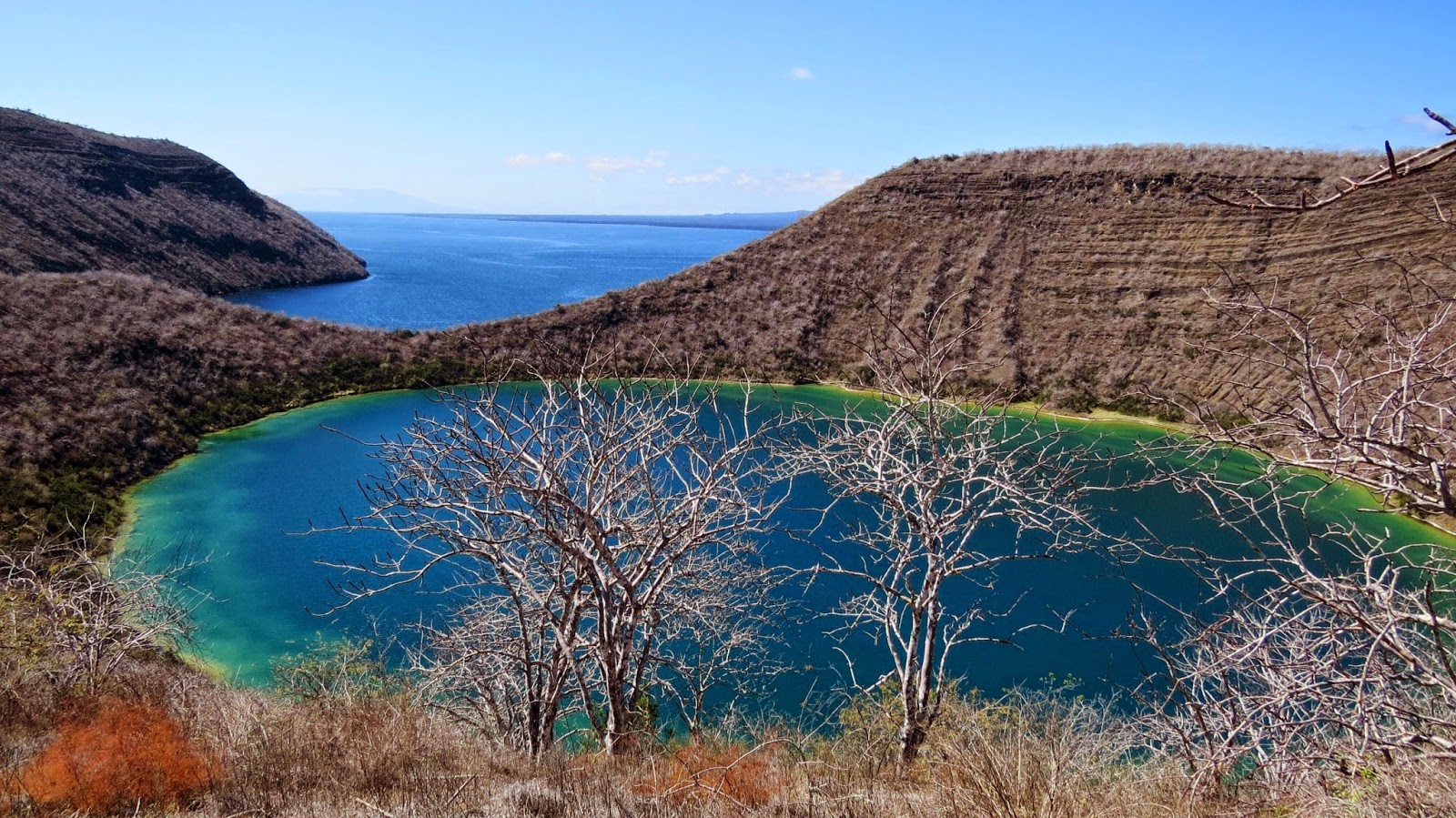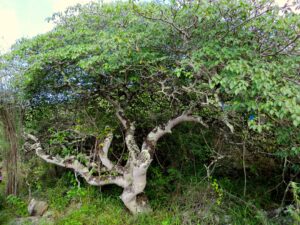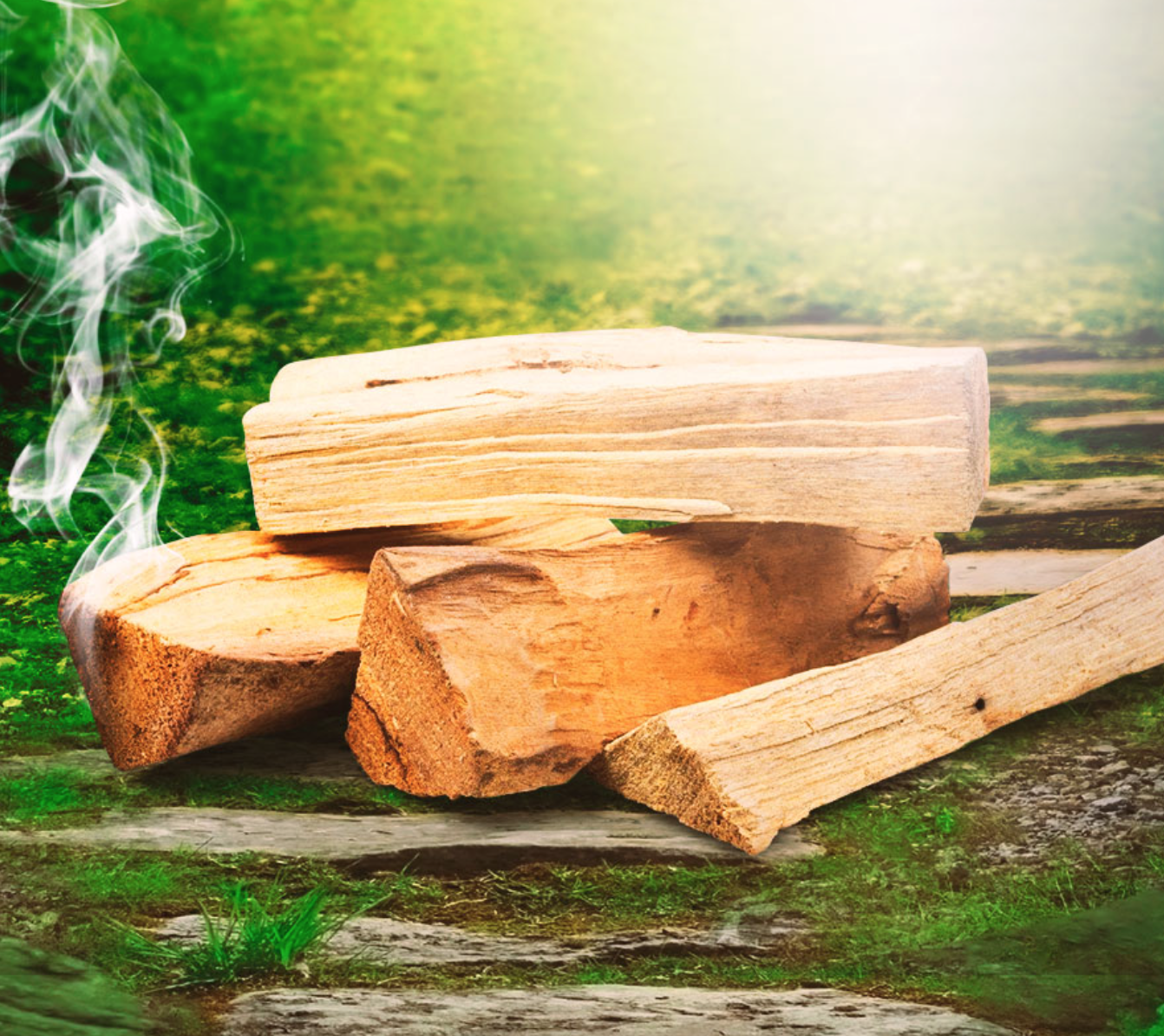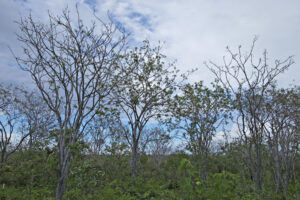Palo Santo is an aromatic wild-growing tree that belongs to the Burseraceae family, the same group to which belong Myrrh, Frankin-cense, Copal sanctum, etc. The name is derived from Spanish and means “holy wood”. It refers to an age-old healing practice structured in the knowledge and ceremonial tradition of South- and Mesoamerican shamans or healers – “curanderos”.
The tree with its wonderfully shaped foliage, white blossoms, and reddish fruits is widely used for ornamental effects. It is native to the tropical forests of Peru, Ecuador, and its Galapagos Islands with their long severe dry, and brief wet seasons. Palo Santo as one of the majestic giants has survived the ongoing destruction of the Amazonian jungle. The tree may reach a height up to 30 meters and prefers shadowy and damp locations tolerating rather low temperatures. The spicy scent of the tree radiates the embracing warmth of a very special wood with overtones of a light herbal, mint-like freshness.

“The tree that perfumes the axe that wounds”
Palo Santo, known among the indigenous people of Ecuador as “the tree that perfumes the axe that wounds”, reminds us of a universal mystery, expressed in the symbols of a paradox: encountering pain or being frightened by death is a secret key opening the gates of a possible resurrection. It bears in itself the curiosity of going further in our existential questions and promises the reward of a spiritual healing and a healing substance born of light.
With its astonishing fragrance, the beautiful resin of the tree can be considered as a symbolic gift of Mother Nature gained by accepting the challenge of an inevitable inner transformation. And the tree expresses it perfectly: By impact mostly of a specific insect, it naturally has to die after a period of up to 100 years of growth. Lying untouched on the ground it takes up to 10 years of maturation until develops the precious resin from the deadfall through a special biochemical metamorphosis. So then, referring to the union of death and rebirth, the resin-rich heartwood of the tree marks the line of a transition not only within the natural seasonal rhythms but also – symbolically – within the human life cycle in general. The aging process of the wood is like the aging process of the human body. The resin of the tree needs what I call the manifold “self-distillation” process through a lifetime in order to ensure that it has gathered all the subtle information for the development of its precious substances. It is especially the resins in trees that are linked to this secret of “death and rebirth” within the cosmic cycles of Nature.
And the precious substances in the human body ? one may ask. Well, the process of “death and rebirth” has very well its counterpart or parallel on the side of us humans. No maturing of the soul is possible without the time, and the body serves as a “vehicle” to let this dance between light and shadow happen in order to trigger the alchemy of the ever glowing “spirit in the matter” which is our human “resin”. 🙂 Without a proper amount of time to learn to let go (to die), without a proper time to fall down and stand up again and again (to get humble) our own precious inner “resin” will not develop. Ayurveda would say it needs time to integrate the “juice of life” or Soma inside the living structure of man. It needs definitely the time factor and the time “factory” in order to become a fully powered “aromatic” human being… 🙂 🙂
As to the ethnobotanical use, Palo Santo since times immemorial is revered and used within the traditional religious life and the daily rhythms for its purifying properties. Given this spiritual and cultural context, it is considered a sacred wood used as incense for honoring the dead as well as for transforming and restoring the subtle energetic fields within human beings. The age-old folklore of native tribes prescribes ceremonial fumigations with Palo Santo wood helping to expel negative energies through the practice of special curing rituals and thereby ensuring healing and well-being.
Interesting to know that:
“those who harvest this wood discovered that there are not only male and female Palo Santo trees, but that they grow in groups of one male and eight females. The lone male outlives his female counterparts by a long shot. While female trees tend to live around 40-50 years, the male can live up to 200 years. Their wood also has distinct characteristics… Shamans teach that these trees have a distinct spirit that lives in the wood long after the tree’s life has ended.(https://www.nattynaturals.com/blogs/news/so-whats-the-rave-about-palo-santo)
In a very practical way, the fumigated wood is also used in houses for cleaning and as an insect repellent. The smoke of the burning wood reveals a realm of some very useful applications within daily life: It is also needed for protecting the home, livestock, and clothing from negative contagious influences like parasites and microbes. Old Spanish chronicles already mention the use of Palo Santo as perfume and incense.
A rather recent discovery in the world of Aromatherapy
The powerful essential oil is obtained by steam distillation from the powdered wood of the fallen tree with its concentrated resin. Only licensed people today are allowed to harvest the wood from the trees, usually by just cutting some of the branches. Some time ago Palo Santo
has been a subject of deforestation, but the governments of Ecuador and Peru have established procedures that protect the trees as well as the indigenous population of many villages for which Palo Santo is part of their livelihood. Therefore, it is always good to make sure that the oil is derived from legal harvesting and that no cutting of living trees for low-quality exploitation is practiced.

Anyway, as we have seen, the deeply aromatic substance develops only via maturation through time and only then bears in itself the biochemistry and energy for healing and inner transformation.
Besides its former homeopathic applications, it is a rather new development that modern aromatherapy has put its focus on Palo Santo and the essential oil derived from it. From a medicinal level, due to certain chemical compounds such as limonene, turpentine, and others, Palo Santo has proven its benefit as an invaluable antiseptic oil for the treatment of various ailments of the skin such as sprains, joint pains, wounds, and other injuries. It is also applied in special therapeutic formulas as a remedy against cold, respiratory diseases, and headaches.
On the psychosomatic level, Palo Santo assists in subtle energy work for meditation. It raises the mood of the practitioner and on the emotional level helps against depression and fear giving trust into the healing dynamics of former uncovered traumatic layers.
Within ayurvedic massage therapy, the subtle energies of the essential oil help implanting a new balance within the often disharmonious energies of the body. Being deeply absorbed by the neurologic system the Palo Santo oil instills a positive quality into the electro-magnetic and bio-photonic field of the human aura.

How to use Palo Santo oil
- As a non-skin irritant, it can be used directly on the skin for example on the wrist, the neck, and the temples.
- As a massage oil: Mixed with a carrier oil (i.e. Sweet Almond oil, Sacha Inchi, etc.) Also in combination with essential oils such as Frankincense, Myrrh, Sandalwood, and other wood and resinous oils.
- As a room fragrance: Also in combination with other essential oils.
- As a meditation enhancer: Alone or in combination with other essential oils.
- When traveling: A few drops placed on the wrists and back of the neck as a protective shield against environmental influences.
Palo Santo Hydrolat
As always in the distillation process, this wonderful Palo Santo wood yields a beautiful hydrolat.
How to Use it:
- As a Meditation Enhancer: Use as an ‘aura’ mist before yoga, meditation, etc.
- Benefits: Help to ground and calms the mind.
- Creativity Mist: Use as an ‘aura’ mist.
- Benefits: Both calms the nervous system and awakens mental faculties. Great for workspaces to stimulate creativity and inspiration.
- Make a hot or cold Compress: Saturate the washcloth with 1/2 bottle cold or warm Palo Santo hydrolate – Ring out – Fold washcloth flat and place on the chest. Leave on for 10 minutes or more. Repeat as often as desired. Using more hydrolat for your compress or diluting it with water (up to 1/2) is also an option.
- Benefits: To clear the lungs and support breathing.
- As a clearing roomspray: Spray around any environment many times a day.
- Benefits: Enhances connection and uplifts the spirit. Purify from any negative energy. Very useful in hotel rooms and on hotel mattresses to clear all the ancient energy of previous guests.
- As a Yoga mat spray: Spray on, leave on for 1 minute and wipe off. Refreshes and purifies stale mats.
- Test patch your particular mat first for compatibility.
